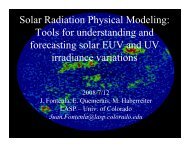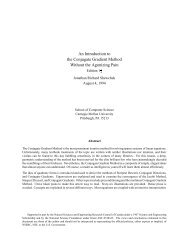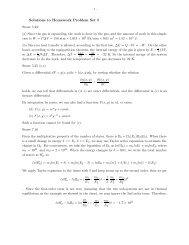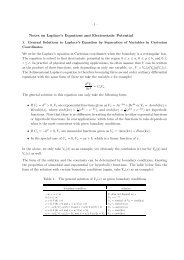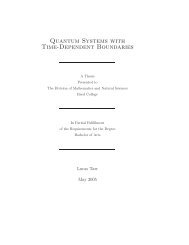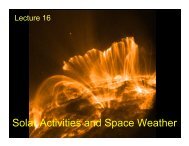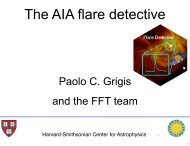The Topology of Magnetic Reconnection in Solar Flares
The Topology of Magnetic Reconnection in Solar Flares
The Topology of Magnetic Reconnection in Solar Flares
You also want an ePaper? Increase the reach of your titles
YUMPU automatically turns print PDFs into web optimized ePapers that Google loves.
2<strong>The</strong> release <strong>of</strong> this large amount <strong>of</strong> energy has a variety <strong>of</strong> effects throughout the solarsystem. On Earth, solar flares can <strong>in</strong>teract with our magnetic field and cause aurora as wellas impact many man-made systems such as radio communication, navigation, satellites,aircraft, power grids and pipel<strong>in</strong>es. As a recent example, nearly half <strong>of</strong> the satellites thatcomprise the Global Position<strong>in</strong>g System (GPS), used <strong>in</strong> a wide range <strong>of</strong> important navigationsystems, were temporarily shut down as the result <strong>of</strong> a solar flare <strong>in</strong> December <strong>of</strong>2006.In order to reduce the negative effects on such <strong>of</strong> systems, we need a way to predictwhere and when solar flares will occur. <strong>The</strong> accurate prediction <strong>of</strong> flares is likely years <strong>in</strong>the future, but the more we are able to comprehend the physical nature <strong>of</strong> flares, the closerwe will come to this goal. While it is now commonly accepted that solar flares are driven bythe release <strong>of</strong> energy stored <strong>in</strong> magnetic field configurations, our theoretical understand<strong>in</strong>g<strong>of</strong> how this energy is stored and released is far from comprehensive. In this dissertation, Icomplete a detailed analysis <strong>of</strong> flar<strong>in</strong>g active region magnetic fields <strong>in</strong> an effort to furtherour <strong>in</strong>sight <strong>in</strong>to this scientific question.Flare Energy ReleaseAn example <strong>of</strong> a typical large flare is the M5 flare that occurred on 4 November, 2004.Figure 1.1 shows two light curves <strong>of</strong> this flare, one <strong>in</strong> the 6-12 keV (SXR) energy bandand one <strong>in</strong> the 25-50 keV (HXR) band. <strong>The</strong>se light curves were generated from data takenby the Ramaty High-Energy <strong>Solar</strong> Spectroscopic Imager (RHESSI L<strong>in</strong> et al., 2002), whichobserves the Sun <strong>in</strong> HXR and gamma-rays. While both the light curves rise at approximatelythe same time, the 25-50 keV band peaks prior to the 6-12 keV band. This lag<strong>in</strong> SXR emission, known as the Neupert effect (Neupert, 1968; Hudson, 1991), is due tothe physical process that transfers the energy <strong>of</strong> flare accelerated nonthermal electrons <strong>in</strong>toheat<strong>in</strong>g. In the thick-target bremsstrahlung model, where, due to collisions, the spectrum <strong>of</strong>



